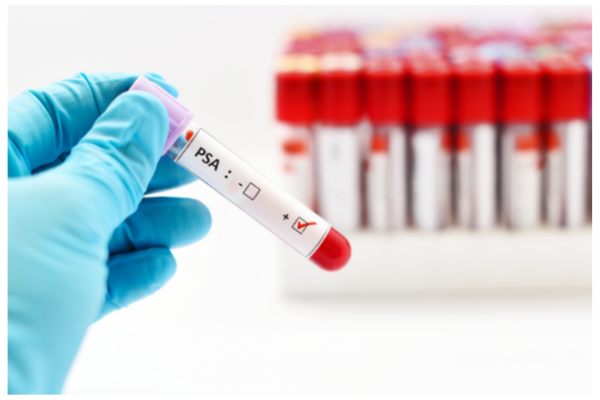Who is at risk for prostate cancer?
Prostate cancer is very common. It affects approximately 13% and causes early death in 2% to 3% of men in the U.S. The risk of developing prostate cancer increases with age, with 60% of cases occurring in men 65 and older. While all men are at risk for prostate cancer, men with African ancestry are diagnosed more frequently, at younger ages, and with higher-risk cancers than others. Men whose father or brother had prostate cancer are at more than twice the normal risk.
What is a PSA test?
A PSA test is a blood test that measures the concentration of prostate-specific antigen (PSA), a protein produced by the prostate gland. It’s used as a prostate cancer screening tool because this condition can cause PSA to be elevated. The American Cancer Society (ACS) advises men to make an informed decision with their health care provider about whether to undergo PSA screening. For men at average risk of prostate cancer, they recommend this discussion take place at age 50. For men at higher risk levels, the ACS recommends having this conversation at age 40–45, depending on the risk factors involved. Several benign conditions, including inflammation, infection, or enlargement of the prostate, can also cause increases in PSA levels. PSA tests are also used to assess treatment progress or recurrence in patients who have been diagnosed with prostate cancer.
What symptoms suggest elevated PSA?
Men with elevated PSA often experience urinary symptoms. These may include difficulty urinating, a slow urine stream, frequent urination, and urinary incontinence. It’s common for men with elevated PSA to have to get up multiple times during the night to use the restroom. Other symptoms may include
- Pain during urination, ejaculation, or bowel movement
- The feeling that the bladder cannot be fully emptied
- Blood in the urine or semen
- Pain in the low back or lower abdomen
- Cloudy, unusual smelling urine
What if my PSA level is elevated?
What happens after an elevated PSA finding can vary depending on the individual patient and their doctor’s assessment of their condition. Below are some common recommendations.
Repeat PSA
When a PSA test returns an abnormal PSA result, the physician may first order a second PSA test to confirm the result. PSA levels may temporarily increase due to various short-term influences, including sexual activity and vigorous exercise. Repeating the test helps eliminate unnecessary intervention in these cases.
DRE
Whether or not the PSA test is repeated, the doctor will often pair the test with a digital rectal exam (DRE) to check for masses. Because many tumors found via PSA testing are slow growing, repeated PSA tests with DRE may be recommended to determine if changes are occurring over time.
Prostate MRI & Biopsy
If testing leads the doctor to suspect prostate cancer, they may order a prostate MRI to look for a mass and/or an ultrasound-guided prostate biopsy to test for malignant cells. Prior to a prostate MRI, a patient is directed to abstain from eating or drinking for at least six hours.
A prostate MRI uses a powerful magnet and gadolinium contrast dye, which is injected into the arm, to create detailed three-dimensional images of the prostate. For patients other than insulin-dependent diabetics, a glucagon injection is also administered; this helps relax the muscles of the GI tract, allowing for clearer imaging. Modern technology allows images to be obtained via a coil laid over the abdomen rather than relying on a rectal coil or probe, creating a more comfortable experience for patients. The exam itself takes about 45–60 minutes of a 60–75-minute appointment, and results are sent to the referring physician within two business days.
A prostate biopsy is performed using ultrasound and sometimes also MRI guidance. During the procedure, the area is numbed, and then multiple tissue samples are taken using a spring-loaded needle. This can be done either through the rectal wall (transrectal) or through the perineum (transperineal). The samples are then analyzed in the lab for the presence of cancer cells. If prostate cancer is identified, MRI may then be used to identify any additional masses that may have been missed in the initial assessment.
Iowa Radiology provides state-of-the-art imaging services including wide-bore MRI and imaging-guided biopsy for diagnosis and assessment of prostate cancer. See our free guide to learn more about MRI, or subscribe to our blog to stay up to date on all our latest health articles.
Resources
American Cancer Society. Prostate Cancer Risk Factors. Cancer.org. https://www.cancer.org/cancer/prostate-cancer/causes-risks-prevention/risk-factors.html. Revised June 9, 2020. Accessed June 29, 2022.
Centers for Disease Control and Prevention. CDC.gov. https://www.cdc.gov/cancer/prostate/basic_info/risk_factors.htm. Reviewed August 23, 2021. Accessed June 29, 2022.
Mayo Clinic. Prostate Biopsy. https://www.mayoclinic.org/tests-procedures/prostate-biopsy/about/pac-20384734. Published June 22, 2021. Accessed June 29, 2022.
National Cancer Institute. Prostate-Specific Antigen (PSA) Test. Cancer.gov. https://www.cancer.gov/types/prostate/psa-fact-sheet. Reviewed March 11, 2022. Accessed June 29, 2022.
Villines Z, Rees M. 8 causes of an elevated PSA that are not cancer. Medical News Today. https://www.medicalnewstoday.com/articles/319551. Reviewed May 31, 2022. Accessed June 29, 2022.


